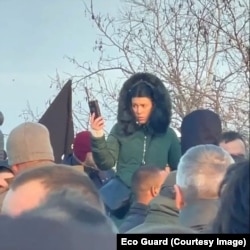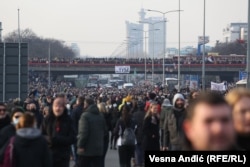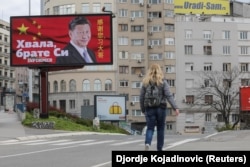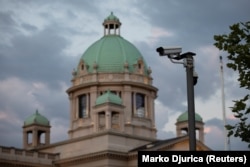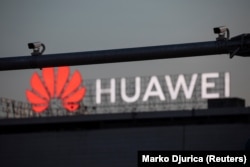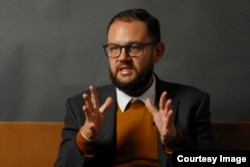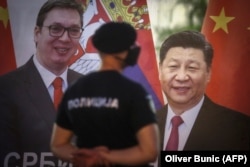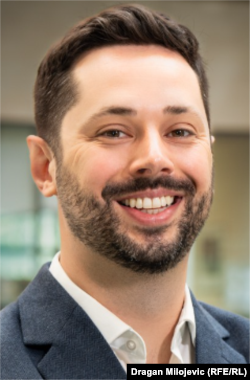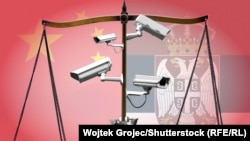
BELGRADE -- As hundreds of thousands of people filled the streets across Serbia in late 2021 to protest weak environmental standards and changes in the law to the benefit of a foreign company’s plan to mine lithium, images began circulating that alarmed activists and tapped into a multiyear political fight over the expansion of Chinese surveillance technology.
In the photos and videos shared by environmental groups on social media, what appeared to be plainclothes police can be seen filming crowds of protesters with a device that Serbian authorities later said was a Huawei EP 821 trunking terminal -- equipment increasingly used by Chinese security forces that Serbian police bought from China as part of a security-cooperation agreement.
The countrywide, monthslong protests were the largest to sweep Serbia in decades and the government eventually backed down and repealed the proposed legal changes that sparked the outcry. But the appearance of the Huawei device in the hands of alleged law enforcement officers triggered accusations that officials had begun using facial-recognition technology to identify protesters, despite there currently being no law that allows its use.
Concerns were further fueled when more than 1,000 misdemeanor traffic violations were issued to protesters following the demonstrations for blocking roads and other traffic offenses.
“We don’t know if it was facial-recognition technology or not. At the end of the day, the actions we saw [from the authorities] were about scaring and intimidating people,” said Bojan Simisic, the founder of the environmental NGO Eco Guard, which was among the first to raise suspicions about the use of the Huawei devices at the protests. “Our biggest worry is that technology like this could be used to help make a database of people that are not desirable in the eyes of the authorities.”
The government has already deployed thousands of surveillance cameras across the country as part of plans to introduce some 8,000 Chinese-made Huawei surveillance cameras with facial-recognition capabilities. That rollout has faced public resistance for years and Belgrade says that facial-recognition software is not yet deployed, but the use -- and potential abuse -- of the technology has been a source of concern for activists, the country’s political opposition, civil rights groups, and cybersecurity experts.
With a political flashpoint looming, the appearance of the new devices at the protests looked to be the beginning of the worst-case scenario they had warned about.
While many protesters were stopped by police and showed their IDs on the spot, others say they were never formally identified at the protests and their fines -- which were issued by mail, dozens of which have been seen by RFE/RL -- state that video footage was used to identify them.
Serbia’s Interior Ministry did not respond to RFE/RL’s requests for comment, but it has previously denied that any facial-recognition technology is deployed in the country and an inspection of the ministry over the potential use of facial-recognition software during the protests by the commissioner for Information of Public Importance and Personal Data Protection, an independent government body, found that it had not been used.
An RFE/RL investigation did not find any instances of facial-recognition software being used at the protests or elsewhere in Serbia. But reporting based on court documents, police testimony, misdemeanor warrants issued to protesters, Interior Ministry documents, and interviews with experts, officials, and activists shows that Serbian law enforcement conducted a widespread and legally murky operation with plainclothes officers to film and surveil protesters with the aim of identifying them on video.
That strategy, experts and watchdogs say, raises concern about how Serbian officials could abuse cutting-edge Chinese surveillance tools like facial-recognition software once a legal basis for it is established in the country.
“Police used video footage to recognize protesters, but we also have verdicts from the courts when we challenged [the fines] and police couldn’t testify to who determined their identity and the court concluded that the police officer didn’t actually identify the protester themselves,” Sreten Djordjevic, the lead lawyer at an environmental law office that represented multiple protesters who disputed their fines, told RFE/RL.
Djordjevic and other lawyers who worked on similar cases acknowledge that this is not evidence of facial recognition being used, but that it raised “suspicious patterns” about how police identified protesters that could have far-reaching consequences as Serbian authorities look to roll out a wider array of Chinese-made surveillance tools across the country.
“The result of this was the police essentially creating ‘lists’ of activists and other citizens who are critically inclined toward the government,” Tara Petrovic, the lead researcher at Civic Initiatives, a legal organization that assisted hundreds of protesters fined at the demonstrations, told RFE/RL. “How police went about this raises lots of legal questions and leads to worrying conclusions about abuse of personal data and how they deploy the resources and technology available to them. In practice, this was a system of low-tech facial recognition.”
A 'Low-Tech' Experiment
Throughout Europe and North America, one of the leading concerns around facial recognition and its spread from Chinese vendors like Huawei is that it can be used to strengthen authoritarian regimes and be abused to curb dissent rather than its stated use of helping law enforcement pursue and locate criminals and terrorists.
Experts say this makes Serbia a vital test case for Chinese surveillance infrastructure beyond its borders. The country’s current political climate has seen a chill under the leadership of President Aleksandar Vucic, with the watchdog group Freedom House saying Serbia has experienced an erosion of political rights in recent years that has put pressure “on independent media, the political opposition, and civil society organizations,” and ranks the country’s political system as “partly-free.”
Under Vucic, Serbia has deepened its ties with Beijing.
Investment from China has poured into Serbia, and Belgrade has taken out billions in loans from Chinese institutions. Security-related projects have also taken up an increasingly prominent position, primarily when it comes to domestic security and cooperation in “law enforcement and surveillance technology” between the two countries. Serbia is also a member of China’s Belt and Road Initiative (BRI), which has been a conduit for Chinese infrastructure projects across the world and increasingly digital technologies such as telecommunications networks and surveillance tools.
“Serbia has already become a laboratory for Chinese influence and projects, with technologies like facial recognition being the next frontier,” Vuk Vuksanovic, a researcher at the Belgrade Center for Security Policy, told RFE/RL. “The government is currently looking for a legal loophole to make it into a reality.”
Beyond the use of facial-recognition technology, Serbian authorities have also been tied to other controversial cases of surveillance and breach of privacy.
The editor of the Belgrade-based Crime and Corruption Reporting Network (KRIK), a leading investigative outlet in the Balkans, has had his personal correspondence intercepted and leaked on multiple occasions to pro-government tabloids. Meanwhile, Citizen Lab, a research center at the University of Toronto has published investigations about the use of various spyware and surveillance tools by Serbian customers, with one report linking it to the country’s Security Intelligence Agency.
In the case of the November and December 2021 protests against the lithium-mining operations in Serbia of the Anglo-Australian company Rio Tinto, court minutes and verdicts reviewed by RFE/RL -- as well an analysis of 254 cases by Civic Initiatives -- show police saying they were under orders to not break up the demonstrations and were instead told to film protesters with the intent of recognizing them afterwards from the footage.
In one instance, according to testimony from a police officer, footage was placed on a screen in a precinct and officers were told to point out people that they recognized. Other court verdicts include testimony from officers saying they were given quotas for how many people they had to identify.
Recognizing protesters was more straightforward for the authorities in smaller towns where police knew members of the community or instances that involved well-known environmental activists or opposition figures. In other cases, officers combed through social media profiles to identify people from videos of the protest. In multiple instances, cases were thrown out by judges because police could not prove people were informed that they were being filmed by the authorities, as is stipulated by law.
“From the verdicts that we've seen, it is not clear how exactly footage was put together [to identify protesters], but it looks like it played an important role,” Petrovic said.
An Uneven Expansion
As complaints and concerns from the public grew, Milan Marinovic, Serbia’s commissioner for Information of Public Importance and Personal Data Protection, was tasked with looking into breaches of personal data and whether facial-recognition capabilities were used at the protests.
“At this moment in Serbia we don’t have a legal basis [to use facial recognition],” Marinovic told RFE/RL in an interview. “Secondly, it’s my understanding that we don’t have the appropriate software yet.”
Serbia obtained its thousands of Huawei cameras from China through a Safe City project that came out of a strategic partnership Belgrade signed with Huawei in 2017. These technologies represent a complex new frontier for China that allows police across China to gather material from tens of millions of cameras -- as well as from billions of records of travel, Internet use, and business activities -- to keep tabs on citizens and better manage cities.
Defenders of these projects say that they offer major efficiency gains by automating city operations and building up systems already in use in democratic countries. Meanwhile, critics argue that such technology helps entrench authoritarian political leaders and are exported from China with diminished transparency and accountability. Huawei has maintained in past statements that it is only a manufacturer and vendor and responsibility ultimately lies with the user.
Marinovic’s office is tasked with reconciling Serbian law with the strains on privacy and data protection that these new technologies present. As accusations of the government using facial recognition with no legal basis continued to circulate amid images of the plainclothes officers filming with new devices, he launched an inspection of the Interior Ministry to inquire about the device and the images.
The commissioner’s findings, a summary of which were later published, found that the device in question was Huawei’s EP 821 trunking terminal, which the ministry stated has no software or hardware functionality for facial recognition. Such devices have become increasingly used by Chinese law enforcement, and Huawei and other Chinese vendors market them as an all-in-one police radio, body camera, and smartphone that is capable of taking and transmitting photos and video.
Charles Rollet, an analyst at IPVM, an industry publication focused on video-surveillance products, told RFE/RL that such devices do not have facial-recognition capabilities “but clearly, taking pictures of protesters or filming them with such a device could easily be used for facial recognition on the backend.”
Huawei’s Safe City projects rely on a real-time deployment of facial-recognition technology, which compares live camera feeds with a database, whereas other software can be used to search for certain faces through previously recorded footage.
RFE/RL obtained copies of the inspection conducted by Marinovic’s office of the Interior Ministry and also the ministry’s reply to the request for information.
In those documents, the ministry restated that it does not have any ability to use facial-recognition technology and acknowledged that they have similar Huawei devices in use, although they said they couldn’t confirm the identity of the persons caught using them to film protesters and said it could not determine if they were ministry employees and what the purpose of their filming was.
The documents are written in couched legal language and while the ministry says that it did film protesters, it stresses that police followed proper procedure for doing so and that they can’t confirm if the Huawei device was used to film protesters. The response from the ministry was issued in January, several months before the first misdemeanor fines began to be challenged legally and vast irregularities with how police identified protesters were exposed in court documents.
Despite Marinovic’s findings that facial recognition was not used, his report has done little to calm the fears that the incidents around the environmental protests have raised over potential misuse in the future.
There is currently no legislation in Serbia for the mass biometric surveillance that the cameras it purchased from Huawei could allow -- but authorities continue to look for ways to legalize the facial-recognition tools.
Marinovic said the Interior Ministry has sent two case studies to his office since he assumed the role in 2019 on how the use of the technology would affect the protection of personal data. He said both were rejected for not sufficiently providing safeguards to ensure that only the data and details of wanted or missing persons could be accessed.
In 2021, the ministry put forward a draft proposal on biometric surveillance included within new police legislation called the Law of Internal Affairs, which would have granted them wide-ranging authority over personal-data collection. Local civil liberties groups caught the changes and quickly mobilized, engaging with members of the European Union Parliament and international human rights groups as well as protesting. After two days of pressure, the Serbian government withdrew the draft law, but did not renounce it.
Marinovic remains critical of the ministry’s attempt to pass through the draft law in an underhanded way but said it is likely to press ahead with finding a way to create the law -- a scenario that many analysts see as rising after Vucic’s Serbian Progressive Party won a majority in parliament in April.
The commissioner said he sees his main task as finding a solution that prioritizes data protection and can ensure that human rights in the country are guarded. But there is also a sense of inevitably about the rollout of facial-recognition capable cameras in Serbia and elsewhere.
“I can imagine that this [technology] won't only be part of Serbia’s future, but everywhere,” Marinovic said.




